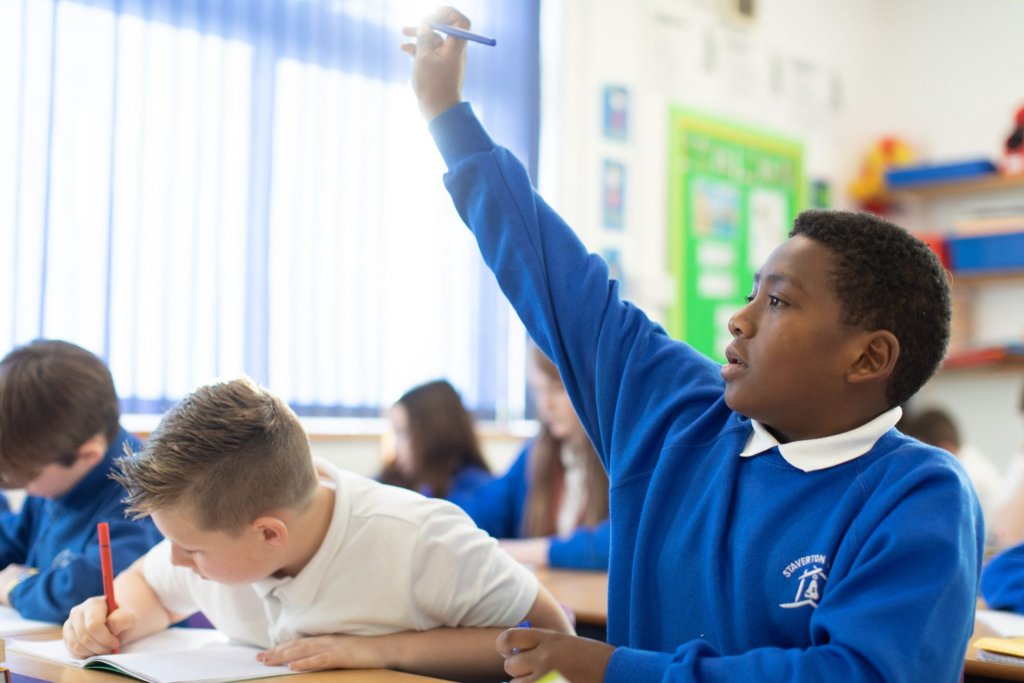English

Reading
At Staverton, we seek to foster an innate love of reading where our pupils choose to read. Engaging reading opportunities are provided across the school.
All classes are able to enjoy our recently developed library and all children will regularly visit Trowbridge library and become members there. Our classroom book corners are also well stocked with a wide selection of reading material.
This is what we do
From when children have finished RWI phonics, they are taught a stand-alone guided reading lesson every day. The texts and core principles of these lessons have been carefully designed and a reading spine has been established in every year group. Teachers teach a new fiction text each term. The choice of age-appropriate non-fiction texts are decided by the class teacher and incorporated into guided reading sessions when appropriate.
Each reading lesson from year 1-6 lasts no less than 30 minutes and covers a range of skills. Every lesson includes a specific focus on vocabulary and children will engage in active reading every day. There is a balance of oral and written responses to reading. Where a written response is appropriate, these are documented in the children’s reading exercise books.
This is why we do it
We believe that every child has the right to be an outstanding reader and that it is our responsibility to ensure reading is taught consistently and progressively throughout the school. We believe the children need the highest standards and expectations so they become confident readers across the whole curriculum. These principals remain part of our rationale for the way we teach reading:
- Teachers all model a love of reading and are knowledgeable about children’s literature.
- Read Write Inc is taught comprehensively across the school and the same strategies are employed in reading lessons for segmenting, blending, etymology of words and error corrections.
- Reading for pleasure lessons are carefully planned and visits to the library are planned weekly.
- Children have the right to be taught a range of literature, following our reading spine of over 40 quality texts.
- When planning lessons, teachers are knowledgeable about exactly which skills children need to develop.
- Vocabulary teaching features in every lesson.
- Daily lessons are timetabled and rigorously taught.
Furthermore, we have included research by Doug Lemov (Reading Reconsidered) and Aidan Chambers (Tell me) in our pedagogy to improve the thinking behind the way we present activities to children and how we are guiding them, not leading them to formulate quality responses independently in response to their reading. Further rationale includes:
- Children read harder, more challenging material.
- We are aware of the ‘five plagues for developing readers’ and choose reading material to familiarise children with these and remove potential barriers.
- We teach children to ‘close-read’ texts to allow for deeper analysis.
- Children need to write effectively in response to reading.
- We balance teacher: pupil talk and teacher: pupil reading, knowing when each are appropriate to ensure teaching is meaningful and effective.
We recognise that alongside the reading lesson, children will need to be supported in ensuring the independent reading material they access is age-appropriate and sufficiently challenging whilst being accessible. This is carefully monitored and children requiring further support will have their needs met through additional provision.
This is what it looks like in the classroom
- Teachers use a wide range of teaching strategies based on their knowledge of the text and children’s needs.
- All teachers and TAs have read in advance the key text from the reading spine which is the focused literature study.
- The skills and language of reading are modelled explicitly by all adults to a high level.
- Adults ask carefully planned questions which evoke careful, considered responses from the children. This is targeted, most often open-ended and encourages participation, whilst valuing the opinions of all pupils.
- Children talk confidently and enthusiastically about the books they are reading both at school and at home.
- Children confidently use the language of reading to analyse text maturely. (e.g. … I predict that ‘X’ will go behind his mother’s back because I can infer by his facial expression that he does not agree with what she’s saying. A quote to support this would be…’)
- Children are well-versed in the routines of reading e.g. in a pair, aloud, answering questions and tracking the text using a lollipop stick. Minimal reminders are needed.
- All children have equal opportunities to engage and contribute to discussions in reading.
- The books children read at home are carefully matched to the child’s reading stage and their home reading is monitored closely by the teacher.
Reading Spine
As a school, we are currently working on developing a reading spine. This will start in full from next academic year and we are currently using some of the Year B books to support reading and writing in class.
Writing
We want to enable children to use the written word in order to communicate purposefully with others.
Writing is developed, shared and celebrated across the school. KS2 follow a structured spelling scheme and a secure handwriting scheme is used across the school.